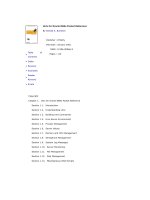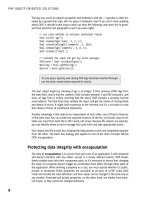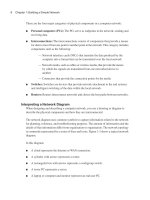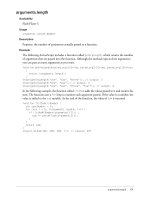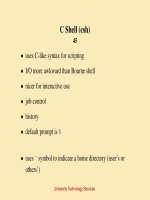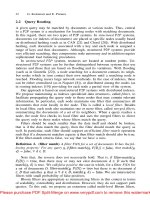Tài liệu DBA Handbook for Oracle P2 ppt
Bạn đang xem bản rút gọn của tài liệu. Xem và tải ngay bản đầy đủ của tài liệu tại đây (529.81 KB, 20 trang )
Make sure that there is sufficient memory and disk space.
Specify Oracle SID.
$ ORACLE_SID = slx_db01;
EXPORT ORACLE_SID;
Connect as internal in the server manager mode.
$ SQL> CONNECT SYS AS SYSDBA
$ SQL> STARTUP NOMOUNT
Run the script to create a database.
Run the catproc.sql and catalog.sql while connected
as SYS.
These actions result in the creation of the database
with default datafiles, control files, redo log files,
system tablespace, and data dictionary. The default
users SYS and SYSTEM are also defined.
Create initialization parameter file by copying sample
parameter file init.ora. Make sure that you customize
the parameter to specific requirements since parameters
such as BLOCK_SIZE cannot be changed once set.
CREATE DATABASE slx_db01
USER SYS IDENTIFIED BY sol123
USER SYSTEM IDENTIFIED BY sol123
LOGFILE GROUP 1
('/mnt/sdc1/1159/slx_db01/redo01.log') SIZE 100M,GROUP 2
('/mnt/sdc1/1159/slx_db01/redo02.log') SIZE 100M,GROUP 3
('/mnt/sdc1/1159/slx_db01/redo03.log')SIZE 100M
MAXLOGFILES 5
MAXLOGMEMBERS 5
MAXLOGHISTORY 1
MAXDATAFILES 100
MAXINSTANCES 1
CHARACTER SET US7ASCII
NATIONAL CHARACTER SET AL16
UTF16DATAFILE '/mnt/sdc1/1159/slx_db01/system01.dbf' SIZE 325M
REUSE
EXTENT MANAGEMENT LOCAL
SYSAUX DATAFILE
'/mnt/sdc1/1159/slx_db01/sysaux01.dbf' SIZE 325M REUSE
DEFAULT TABLESPACE tbs_1
DEFAULT TEMPORARY TABLESPACE tempts1
TEMPFILE '/mnt/sdc1/1159/slx_db01/temp01.dbf'
SIZE 20M REUSE
UNDO TABLESPACE undotbs
DATAFILE '/mnt/sdc1/1159/slx_db01/undotbs01.dbf'
SIZE 200M REUSE AUTOEXTEND ON MAXSIZE UNLIMITED;
Chapter 3: Administration Activities
29
SOLIX Technologies (www.solix.com)
3.2 Creating Databases
Oracle Databases can be created either using the Database Configuration
Assistant or a CREATE DATABASE statement. Using the DBCA is easier.
Creating the database manually requires careful planning. Additional actions
such as creating new users, tablespaces and data dictionary tables have to be
performed in case the database is created manually.
To create the database:
NOMOUNT
SMON
SGA
DBWR PMON
LGWR
CONTROL FILESDATA FILES REDO LOG FILES
DATABASE MOUNTED
NOMOUNT
SMON
SGA
DBWR PMON
LGWR
DATABASE OPEN
SMON
SGA
DBWR
PMON
SNNN CKPT
ONNN
CONTROL FILESDATA FILES REDO LOG FILES
CONTROL FILES REDO LOG FILES
Figure 5. Starting Oracle Database.
PMON
LGWR
Chapter 3: Administration Activities
30
SOLIX Technologies (www.solix.com)
3.3 Database Operation
3.3.1 To Start the Database
The database is made operational to the users by mounting and then opening it
Using SQL*Plus to start the database
1. The administrator is required to connect to the SYSDBA.
SQL> CONNECT SYS/sol123 AS SYSDBA;
Chapter 3: Administration Activities
31
SQL> STARTUP
SQL> STARTUP NOMOUNT
SQL> STARTUP MOUNT
SQL> STARTUP RESTRICT
Oracle identifies the file by looking for:
The administrator can instruct Oracle to read initia-
-lization parameters from the initialization parameter
file by using the PFILE clause during the STARTUP command.
STARTUP PFILE =/mnt/sdc1/1159/slx_db01/init_slx_db01.ora;
SQL> Startup
·spfile$ORACLE_SID.ora
·spfile.ora
·init$ORACLE_SID.ora
SOLIX Technologies (www.solix.com)
2. Start up an Oracle Database instance.
Starting Modes
To start the database while mounting the database:
The following statement starts the instance by mounting the database and
opening it at the same time. This mode allows all valid users to connect to the
database and perform operations.
To start the instance without mounting the database:
This is typically done while creating the database.
To start an instance and mount a database without opening the database:
The database is mounted and not opened in case the administrators have to
perform any maintenance operations such as enabling or disabling redo log
archiving files or performing full database recovery.
To start an instance and mount a database without opening the database:
Access to an instance can also be in restricted mode such that the databases are
available only to administrators. The administrators may perform functions such
as exporting or importing database data, loading data using the SQL*Loader, or
performing migration and upgrade operations.
While in the restricted mode, all users that have CREATE
SESSION RESTRICTED privileges can connect to the database.
The database administrators cannot use the Oracle Net
Manager to connect to the database remotely.
This mode is used in case the current instance could not
be shutdown using the normal commands such as SHUTDOWN
NORMAL, SHUTDOWN IMMEDIATE, or SHUTDOWN TRANSACTIONAL
commands.
This would cause the instance to forcefully shutdown in
ABORT mode and restart it.
SQL> ALTER SYSTEM DISABLE RESTRICTED SESSION;
SQL> ALTER SYSTEM ENABLE RESTRICTED SESSION;
SQL> STARTUP FORCE
In case the administrator wants to perform complete
recovery, the instance has to be started and the database
has to be mounted.
Recovery can be performed only in case a recovery is
required. In case the administrator issues recover option
without any requirement, Oracle issues an error message.
SQL> STARTUP OPEN RECOVER
SQL> ALTER DATABASE OPEN;
SQL> ALTER DATABASE OPEN READ ONLY;
Chapter 3: Administration Activities
32
SOLIX Technologies (www.solix.com)
To disable the restricted mode:
To enable restricted session while database is in normal mode:
Force Startup
The administrator can forcefully start another instance of the database.
To start an instance to commence complete media recovery:
To open databases those are closed at the start of the session:
Read Only Mode
Users can open the database and retrieve data without having the ability to
change the contents of the database.
3.3.2 Shutting Down the Database
The database and the instance can be shut down only while being connected as
SYSOPER or SYSDBA. There are different ways of shut down the database.
Normal Clause
The database can be shut down normally using the SHUTDOWN command in
the SQL*Plus.
SQL> SHUTDOWN NORMAL
Once the statement is issued, Oracle stops accepting any
new connections. The database waits for all the users
that are connected to the database to disconnect.
SQL> ALTER DATABASE OPEN READ ONLY;
SQL> ALTER DATABASE OPEN READ ONLY;
The SQL statement processing is stopped.
Requires the instance recovery procedures next time
when the database is started.
SQL> SHUTDOWN ABORT
Chapter 3: Administration Activities
Shutdown Immediate
Shutdown Immediate is typically done when an automated and unattended
backup is to be performed, or power interruptions are anticipated.
Shutdown Transactional
The database starts the shutting down process. The database does not accept
any new connections and all uncommitted transactions are rolled back. The
database disconnects all users immediately. All users are disconnected after the
transactions are completed. This way there is no loss of any data.
Abort
Abort is typically done, if the database has to be shut down instantaneously,
typically within about a minute. No new connections are allowed after aborting.
3.3.3 Quiescing a Database
The database can be put in state that allows only DBA transactions, queries, and
PL/SQL statements to be run on the system. Such a state is called the quiesce
mode.
Some actions such as changing the schema of a database or simply adding a
column to the database could potentially fail, if run in normal state. However,
these transactions can be run while the database is in a quiesced state.
The Database Resource Manager feature has to be activated. The non-DBA
sessions become inactive.
Undo Quiesce
33
SOLIX Technologies (www.solix.com)
All the attempts to change the current resources are
queued until the database state is restored to normal.
SQL> ALTER SYSTEM QUIESCE RESTRICTED;
SQL> ALTER SYSTEM UNQUIESCE;
SQL> ALTER SYSTEM SUSPEND;
The SUSPEND and RESUME commands may be issued from
separate instances.
This feature is mainly used to split a mirror disk or a
file in order to provide a backup.
SQL> ALTER SYSTEM RESUME;
The status of FORCE LOGGING mode remains the same even
after shutting down and restarting the database.
Running the database in the forced logging mode results
in complete recovery.
System performance degrades drastically if forced logging
mode with noarchive mode is enabled.
SQL> ALTER DATABASE NO FORCE LOGGING;
Chapter 3: Administration Activities
34
SOLIX Technologies (www.solix.com)
3.3.4 Suspend and Resume a Database
The database can be placed in suspend mode. In suspend mode, the database
halts all the I/O to datafiles and control files. All existing I/O operations are
completed and new I/O operations are placed in a queue. This command is not
specific to any single instance. All active instances will be placed in quiesce
mode. The initialization of new instances is suspended.
To suspend database:
To resume system:
Force Logging Mode
The logging mode generates redo records in the database redo log. Some DDL
statements such as CREATE TABLE can be run in the NOLOGGING clause to
improve execution speed.
3.4 Space Management
The data blocks are the lowest level in the granular structure that store data on
the disk. Configuring the DB_BLOCK_SIZE initialization parameter can define
the size of each block. The parameters, PCTFREE and PCTUSED, allow the
user to decrease the amount of unused space in data blocks and the amount of
row mitigation between the data blocks.
Views Description
dba_free_space Size of the tablespaces
Extent attributes
Rollback segment attributes
Properties of all object
Undo extent properties
All segment information
Description of all tablespaces
Sizes of various pl/sql objects
dba_extents
dba_rollback_segs
dba_objects
dba_undo_extents
dba_segments
dba_tablespaces
dba_object_size
SQL> SELECT property_value
FROM database_properties
WHERE property_name = 'DEFAULT_TBS_TYPE';
SQL> CREATE TABLESPACE slx_tbs01
DATAFILE '/mnt/sdc1/1159/slx_db01/slx_ts01.dbf'
SIZE 100M;
SQL> Alter tablespace slx_tbs01 READ WRITE;
SQL> ALTER TABLESPACE slx_tbs01 OFFLINE NORMAL;
SQL> BEGIN BACKUP;
Chapter 3: Administration Activities
35
SOLIX Technologies (www.solix.com)
Related Views
3.4.1 Tablespace Management
The tablespaces can be easily managed using the alert system provided by
Oracle. Two threshold levels (Warning and Critical) have to be defined to indicate
that the tablespace is running out of storage space. By default, the warning level
is set at 85% utilization and the critical level is set at 97% utilization.
The SET_THRESHOLD and GET_THRESHOLD procedures in the
DBMS_SERVER_ALERT can be used to set and get threshold values
respectively.
To view the current status of the tablespace:
To create a tablespace:
To change tablespace modes to read/ write:
To back up a tablespace:
1. Make the status of the tablespace offline using the ALTER TABLESPACE
statement.
If in archive mode.
SQL> ALTER TABLESPACE slx_tbs01 ONLINE;
SQL> ALTER TABLESPACE slx_ts01 ADD DATAFILE;
SQL> ALTER TABLESPACE Slx_tbs03 NOLOGGING;
SQL> ALTER TABLESPACE slx_tbs01 MINIMUM EXTENT 128K;
SQL> DROP TABLESPACE slx_tbs01
INCLUDING CONTENTS
CASCADE CONSTRAINTS;
In case excess space is required, new 10-KB extents will
be added up to a maximum of 1000 KB.
SQL> ALTER TABLESPACE slx_tbs01
ADD DATAFILE 'slx_tbs02.dbf'
SIZE 100K
AUTOEXTEND ON
NEXT 10K
MAXSIZE 1000K;
Chapter 3: Administration Activities
36
SOLIX Technologies (www.solix.com)
2. Copy the file from '/mnt/sdc1/1159/slx_db01/slx_df01' to
'/mnt/sdc1/1159/slx_db01/slx_df01'.
3. Make the status of the tablespace online using the ALTER TABLESPACE
statement:
To add a data file to a tablespace:
To add a data file to a tablespace:
Logging Attribute
To alter the extent allocation:
To drop a tablespace:
3.4.2 Rollback Segment
Rollback segment is a database object used to store data necessary to undo any
action that is performed on the database. A table is maintained for every
transaction recognized by the SMON process. In most cases the Automatic
Undo mode is enabled to let Oracle manage the undo files.
SQL> SHOW USER
SQL> Alter USER slx_user01 IDENTIFIED BY new_password
SSQL> CREATE USER Slx_user01
IDENTIFIED BY this_is_the_password
DEFAULT TABLESPACE slx_tbs01
QUOTA 10M ON slx_tbs01
TEMPORARY TABLESPACE temp
QUOTA 5M ON system
- User name
- Authentication method
- Default tablespace
- Temporary tablespace
- Other tablespaces and quotas
- User profile
The default DBA user accounts provided by Oracle are SYS
and SYSTEM.
The User SYS is assigned the password, change_on_install
and owns the Database Data Dictionary.
The User SYSTEM is identified by the Password manager and
owns the additional internal tables and views that are
used by Oracle.
Chapter 3: Administration Activities
37
SOLIX Technologies (www.solix.com)
Related Views
3.5 User Management
Each user must provide a valid user name and password in order to gain access
to the database. To create the user, the following attributes must be specified:
To create a new user:
To display current user account:
To change a user password:
Views Description
dba_segemnts Storage allocated for all database segments
Description of rollback segments
Storage allocated for all database segments
Contains extent and latch information
Contains roll names
dba_rollback_segs
user_segments
v$rollstat
v$rollname
SQL> ALTER USER slx_user01 QUOTA UNLIMITED
On slx_tbs01;
SQL> CREATE USER slx_app_user01
IDENTIFIED EXTERNALLY
DEFAULT TABLESPACE slx_tbs01
QUOTA 5M ON slx_tbs01
PROFILE slx_apps_user
- Oracle Net
- Oracle Net Listener
- Oracle Connection Manager
- Networking Tools
Chapter 3: Administration Activities
38
SOLIX Technologies (www.solix.com)
SQL> GRANT CREATE SESSION TO slx_user01;
SQL> ALTER USER slx_user01 QUOTA 50M on slx_tbs01;
SQL> ALTER USER slx_user01 QUOTA 0 ON system;
To grant a session to a user:
To alter tablespace allocation:
To restrict users from creating objects in the system tablespace:
To allocate unlimited tablespace to a user:
To configure external database users:
3.6 Oracle Network Management
3.6.1 Oracle Networking Components
The implementation of the Oracle Database is often in a distributed environment.
It is critical to manage the connectivity, scalability, and security of the Oracle
Database Network.
Some of the important components that help the administrator are:
Oracle Net
Oracle Net an application layer software that resides on the client and the
database server is responsible for establishing and maintaining the connection
between the server and the client. The main software components that comprise
Oracle Net are Oracle Net Foundation Layer and Oracle Protocol Support. The
Oracle Net Foundation initiates and maintains the connection, whereas the
Oracle Protocol Support helps communicate using the standardized
communication protocols such as TCP/IP or TCP/IP with SSL.
Oracle Net Configuration Assistant - To configure Listeners
Oracle Enterprise Manager - Manage Oracle Net Services
Oracle Net Manager - Built in wizards and utilities to test
connectivity, migrate data, create/ modify network components
-
-
-
CLIENT
APPLICATION RDBMS
ORACLE NETWORK
FOUNDATION LAYER
TCP/IP
NETWORK
LISTENER
ORACLE PROTOCOL
SUPPORT
ORACLE NETWORK
FOUNDATION LAYER
ORACLE PROTOCOL
SUPPORT
DATABASE SERVER COMPUTER
ORACLE NETWORK
Figure 6. Oracle Network.
Chapter 3: Administration Activities
39
SOLIX Technologies (www.solix.com)
Oracle Net Listener
The Oracle Net Listener is a process that runs on the database server. This
process listens for new connections at the server side. The listener is configured
with a protocol address. The clients have to use the same protocol address in
order to send any requests. Once the connection is established the client and
the server communicate directly with each other.
Oracle Connection Manager
The Oracle Connection Manager funnels multiple sessions through a single
transport layer protocol. This helps reduce demand on resources and enables
the server to use fewer connections for incoming requests.
Networking Tools
Some of the Oracle Net services user interface tools include:
3.6.2 Listener
The listener is a process that runs on the client and the server. This process
listens for new communication requests and manages all the traffic on the Oracle
Network. The listener can be configured with one or more protocol addresses.
The configuration parameters pertaining to the listener are stored in the
listener.ora file.
$ lsnrctl STOP [listener name]
$ lsnrctl STOP [listener name]
$ lsnrctl STATUS [listener name]
Connecting to (ADDRESS=(PROTOCOL=IPC)(KEY=EXTPROCVIS))
STATUS of the LISTENER
Alias slx_db01
Version TNSLSNR for Linux: Version 9.2.0.3.0
- Production
Start Date 23-FEB-2005 16:48:57
Uptime 12 days 19 hr. 58 min. 57 sec
Trace Level OFF
Security OFF
SNMP OFF
Listener Parameter File
/mnt/slx_db01/network/admin/slx_db01/listener.ora
Listener Log File
/mnt/slx_db01/network/admin/slx_db01.log
Listening Endpoints Summary
(DESCRIPTION=(ADDRESS=(PROTOCOL=ipc)(KEY=EXTPROCVIS)))
(DESCRIPTION=(ADDRESS=(PROTOCOL=tcp)(HOST=slx_server01.slx.com)
(PORT=1522)))
Services Summary
Service "PLSExtProc" has 1 instance(s).
Instance "PLSExtProc", status UNKNOWN, has 1 handler(s) for
this service
Chapter 3: Administration Activities
40
SOLIX Technologies (www.solix.com)
Sample listener.ora
To start the listener:
To stop the listener:
To display the status of the listener:
Sample Status of the Listener
LISTENER=
(DESCRIPTION=
(ADDRESS_LIST=
(ADDRESS=(PROTOCOL=tcp)(HOST=slx_server01)(PORT=1521))
(ADDRESS=(PROTOCOL=ipc)(KEY=extproc))))
SID_LIST_LISTENER=
(SID_LIST=
(SID_DESC=
(GLOBAL_DBNAME=slx_db01.slx.us.com)
(ORACLE_HOME=/oracle10g)
(SID_NAME=slx_db01))
(SID_DESC=
(SID_NAME=plsextproc)
(ORACLE_HOME=/oracle10g)
(PROGRAM=extproc)))
Click on Net Services Administration link.
Select Listeners from the administer list.
Select start / stop from the actions list.
Service "slx_server01" has 1 instance(s).
Instance "slx_db01", status UNKNOWN, has 1 handler(s) for
this service Handler(s):
"DEDICATED" established:17358 refused:0
LOCAL SERVER
DISPATCHERS="(ADDRESS=(PROTOCOL=TCP)(HOST=10.2.157.3))
(DISPATCHERS=2)"
Views Description
v$dispatcher Description of all the dispatcher
Description of dispatcher attributes
Description of queue status
v$dispatcher_rate
v$queue
Chapter 3: Administration Activities
To display detailed information about the listener:
To display detailed information about the listener:
To use the OEM to start / stop the listener:
3.6.3 The Dispatcher
Each shared server needs at least one dispatcher in order to work. If none of the
dispatchers are configured, then Oracle defines a dispatcher for the TCP
protocol.
Related Views
Configuring A New Dispatcher
41
SOLIX Technologies (www.solix.com)
LSNRCTL for Linux: Version 9.2.0.3.0 -
Production on 08-MAR-2005 12:59:10
Copyright (c) 1991, 2002, Oracle Corporation.
All rights reserved.
Connecting to (ADDRESS=(PROTOCOL=IPC)(KEY=EXTPROCVIS))
Services Summary
Service "PLSExtProc" has 1 instance(s).
Instance "PLSExtProc", status UNKNOWN, has 1 handler(s) for
this service
Handler(s):
"DEDICATED" established:0 refused:0
LOCAL SERVER
$ lsnrctl service
continued on next page
SQL> ALTER SYSTEM SHUTDOWN IMMEDIATE 'slx_Disp02';
SQL> ALTER SYSTEM SET DISPATCHERS = '';
Chapter 3: Administration Activities
To shut down a specific dispatcher:
To shutdown all the dispatcher:
42
SOLIX Technologies (www.solix.com)
Optional Attributes. Description
CONNECTIONS
Specifies the maximum number of network
connection allowed for each dispatcher
Specifies the maximum number of network
sessions
Specifies the max timeout values
Specifies an alias name that is used by the
PMON to register dispatcher processes
Enables the multiplexing feature
Enables pooling
Specifies service names the dispatcher uses to
register with the listeners
SESSIONS
TICKS
LISTENER
MULTIPLEX
POOL
SERVICE
· Tables
· Clusters
· Views
· Indexes
· Synonyms
· Triggers
· Database Links
Managing Schema Objects
Contents
CHAPTER
4
43
SOLIX Technologies (www.solix.com)
TABLE SPACE
TABLE TABLE INDEX
SEGMENT
DATA BLOCKS
EXTENT
8K 8K 8K 8K
8K 8K 8K 8K
Views Description
dba_tables Description of all relational tables in the database
Description of all views in the database
Comments on all tables and views in the database
Description of all object tables in the database
Description of all types in the database
Description of method parameters of all types
in the database
Description of all portioned tables
Description of all LOBS
Description of partitioned columns
Description of partitioned key columns
dba_views
dba_tab_comments
dba_object_tables
dba_types
dba_method_params
dba_part_tables
dba_part_lobs
dba_part_col_statistics
dba_part_key_columns
SQL> CREATE TABLE employee
(slx_emp_id NUMBER(10),
first_name VARCHAR2(30),
last_name VARCHAR2(30) not null,
phone_number VARCHAR2(15),
hire_date DATE not null,
slx_dept_no NUMBER(4)
);
Chapter 4: Managing Schema Objects
44
Figure 7.Oracle Data Storage Architecture
SOLIX Technologies (www.solix.com)
CHAPTER 4: MANAGING SCHEMA OBJECTS
4.1 Tables
Tables are basic units in which data can be stored in rows and columns in the
Oracle database. Each table is identified by a name and a set of columns. Each
column contains values of the same data type and holds a particular attribute.
Separate rules called integrity constraints can be enforced on the data that can
be stored in the column. A row can be defined as a collection of column
information pertaining to a single record. Each table has to be assigned a specific
table space. The user trying to create a table should have appropriate privileges.
Related Views
To create a table:
SQL> CREATE TABLE employee
(slx_emp_id NUMBER(10),
first_name VARCHAR2(30),
last_name VARCHAR2(30) not null,
phone_number VARCHAR2(15),
hire_date DATE not null,
slx_dept_no NUMBER(4)
)
TABLESPACE slx_tbs01
STORAGE (INITIAL 6155
NEXT 6155
MINEXTENTS 128 K
MAXEXTENTS 128 K);
SQL> CREATE TABLE employee
(slx_emp_id NUMBER(10)PRIMARY KEY,
last_name VARCHAR2(30) not null,
phone_number VARCHAR2(15),
hire_date DATE not null,
slx_dept_no NUMBER(4),
compensation_details textdoc_tab,
)
NESTED TABLE compensation_details
STORE AS
compensation_nestedtable;
SQL> CREATE GLOBAL TEMPORARY TABLE
slx_routine
ON COMMIT PRESERVE ROWS
AS
SELECT * FROM routine WHERE activity_date = SYSDATE;
SQL> ALTER TABLE employee MOVE
STORAGE (INITIAL 40K
NEXT 80K
MINEXTENTS 2
PCTINCREASE 0);
The table contains a nested column called the compensation_details.
45
Chapter 4: Managing Schema Objects
SOLIX Technologies (www.solix.com)
Tablespace allocation
The table can be specified to belong to a specific tablespace by including this
parameter towards the end of the CREATE table statement.
Temporary table
A temporary table can be created using the temporary clause. The data in these
tables is deleted at the end of the session.
Nested table
To move table to new Tablespace
SQL> ALTER TABLE employee DROP COLUMN salary;
SQL> ALTER TABLE employee SET UNUSED hiredate;
SQL> DROP TABLE employee PURGE;
SQL> LOCK TABLE employee
IN EXCLUSIVE MODE
NOWAIT;
SQL> ALTER TABLE employee
ADD (bonus NUMBER (7,2));
SQL> ALTER TABLE employee
RENAME COLUMN emp_id TO eid;
The lock table statement can be used to permit a
user or deny the user access to a table. The lock
does not prevent the users to query the table.
SQL> ALTER TABLE employee DROP UNUSED COLUMNS
CHECKPOINT 250;
Remove the Unused Columns by specifying
checkpoints to 250 rows at a time in order to
avoid a potential exhaustion of undo space.
This lock overrides the automatic locking and is
active until either the transactions are committed
or rolled back.
Chapter 4: Managing Schema Objects
46
SOLIX Technologies (www.solix.com)
To lock a table:
The LOCK TABLE statement is used to lock one or more tables.
To add a column:
To rename a column name:
To drop a column name:
To set unused columns:
To remove unused columns:
To drop a table:
SQL> CREATE CLUSTER account_managers
(dept NUMBER(4))
SIZE 512
STORAGE (initial 100K next 50K);
SQL> CREATE TABLE slx_dept01
CLUSTER account_managers (dept_no) AS
SELECT * FROM employee WHERE dept_no = 10;
CREATE TABLE slx_dept02
CLUSTER account_managers (dept_no) AS
SELECT * FROM employee WHERE dept_no = 20;
CLUSTERED TABLES UN CLUSTERED TABLES
ACCOUNT MANAGERS
CLUSTER KEY
STORED AS A CLUSTER
DEPT NO DNAME LOC
EID NAME
SALARY
DEPT.NO
DNAME
DEPT
NO
LOC
SALARY SNAME EMP ID
EMPLOYEE
DEPT
STORED SEPERATELY
Figure 8. Clustered and Unclustered Tables
Descriptions of user's own clusters
Description of all clusters in the database
Description of clusters accessible to the user
user_clusters
dba_clusters
all_clusters
Chapter 4: Managing Schema Objects
47
SOLIX Technologies (www.solix.com)
4.2 Clusters
A cluster is a schema object that contains data from a set of more than one table,
each having one or more columns in common.
Related Views
To create clusters:
A user who wishes to create a cluster must have the CREATE CLUSTER system
privilege.
To add tables to the cluster:
SQL> CREATE OR REPLACE VIEW work AS
SELECT slx_emp_id, last_name, dept_no
FROM employee
WHERE dept_no = 30
SQL> CREATE VIEW location_v AS
SELECT
department.dept_id, department.dept_name,
location.loc_id, location.city
FROM
department, location
WHERE
department.loc_id = location.loc_id;
SQL> ALTER CLUSTER account_managers
SIZE 1024 CACHE;
SQL> ALTER CLUSTER account_managers
DEALLOCATE UNUSED KEEP 30 K;
DROP CLUSTER;
SQL> CREATE VIEW personnel AS
SELECT empno, last_name, dept_no
FROM employee
WHERE dept_no = 7;
SQL> CREATE VIEW work AS
SELECT last_name, slx_emp_id,, dept_name
FROM employee, department
WHERE
Employee.dept_id = department.dept_id;
Chapter 4: Managing Schema Objects
48
SOLIX Technologies (www.solix.com)
To alter a cluster:
The user must have ALTER ANY CLUSTER system privilege.
To drop clusters:
4.3 Views
A view is a logical representation of data that belongs to one or more tables. A
view does not store any data. A view derives its data from the data tables that
are specified in its definition. The tables that view retrieves its data from are
called base tables. Views can be further queried, updated, inserted into, and
deleted from.
To create views:
To join views:
To drop/replace a view:
Join View
A join view has a sub query that contains at least one join. In order to modify the
base table, at least one of the columns in the base table should have a unique
index.
